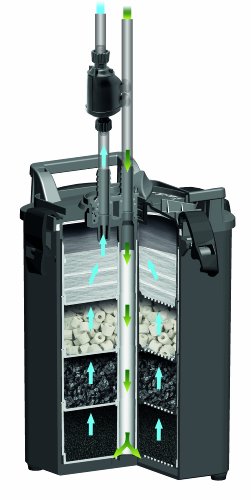Canister filters are pressurized filters that sit below or beside the aquarium and contain filtration media inside of a resealable canister body. Canister filters are often seen as an upgrade from hang-on
power filters because hang-on filters can only be made so big before the weight of the filter puts too much strain on the aquarium glass/acrylic. For many larger systems that are not plumbed through the bottom, they are one of the few choices aquarists have.
Here is a list of the advantages and disadvantages of using a canister filter.
Canister Filter Advantages
Exceptionally Clear Water
Because canister filters can hold exceptionally fine filter media, and pump a large volume of water though them, they are excellent at removing particulates and polishing aquarium water.
Hold Large Volumes of Filter Media
Because canister filters can be significantly larger than power filters, they can hold more media and provide better chemical and biological filtration.
Low Profile
Canister filters sit underneath the aquarium. The only parts of the filter that are visible are the inlet tube and return nozzle. This can be much more attractive than a hang-on power filter.
Do Not Require a Drilled AquariumUnlike sump filters that need a drilled aquarium, or specialized overflow box, canister filters can be used with most standard aquariums. If you do have a drilled aquarium, you can use a canister filter with the holes drilled in the aquarium for an extra low-profile installation.
Canister Filter Disadvantages
Prone To LeakingCanister filters leak more than other kinds of filters, and they seem to always leak at the worst times. If you have a canister filter keep an extra main gasket on hand as this is the most common source of the leak and you will want the leak stopped immediately. Even better, change out your gaskets yearly and apply a coat of
silicone lube to make the gaskets last longer.
Maintenance is Involved and Difficult
Cleaning a canister filter is far more involved than cleaning a power filter or filter sump. Cleaning a canister filter requires turning off the filter, closing the quick disconnect valves, removing the filter hoses, taking the filter to a sink, removing the filter lid, draining the filter, cleaning or replacing all the filter media, lubricating the o-rings, reassembling the filter, reconnecting the hoses, opening the quick disconnect valves, ensuring the filter is primed, and plugging the filter back in.
Need Frequent Maintenance
Because canister filters are exceptionally good at mechanical filtration, and use extra fine filtration media, the filters can clog much faster than other styles of filter. Canister filters should be cleaned at least monthly. In planted and reef aquariums, where there is an abnormal amount of particulates, weekly cleaning is more ideal.
Installation Can Be Hard to Understand
We receive many calls from customers who struggle to get their new canister filter working. The majority of these struggles are related to priming the filter. For a canister filter to turn on, it needs to be filled with water. Many canister filters include a specialized priming lever or button to help with this task. But the first time the filter is set up it can be exceptionally difficult to start the filter this way.
The easiest way to start a filter is to place both the intake line and output line in place and then suck on them to fill them with water. Keep a bucket underneath the aquarium and let the water pour into the bucket and then turn the quick disconnect valve to turn off the water. Once each line has been filled with water, connect the hoses to the filter and open the valves. Your filter should prime automatically and be ready to plug in.
Final Thoughts
Canister filters are a good choice for freshwater aquariums and saltwater fish-only aquariums over 50 gallons. They can be troublesome, but they will keep your water clean. For those with reef aquariums, youíre better off with a
protein skimmer.
We highly recommend getting a drilled through the bottom tank. Itís more work at the start, but it will give you a clean look as it allows you to hide the equipment you donít want to see (
filters, heaters, protein skimmers, probes, thermometers, etc.). When your tank is plumbed through the bottom you can use a sump filter or a
Nu-Clear Filter. A sump filter is basically a filter bag at the inlet of the sump. Filter bags are easy to clean and replace. Nu-Clear Filters require much of the same work as canister filters to clean and maintain, but they have so much more filter material than canister filters they need to be cleaned less often.




























